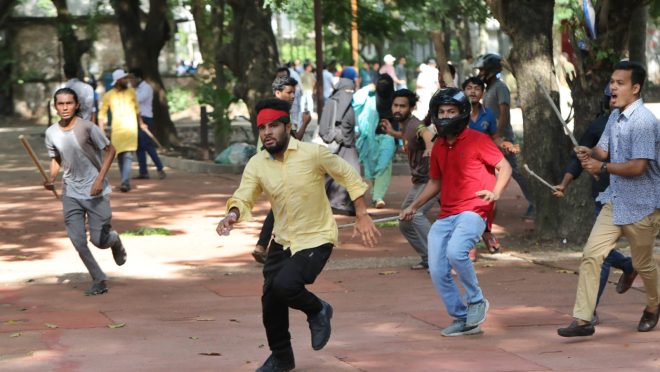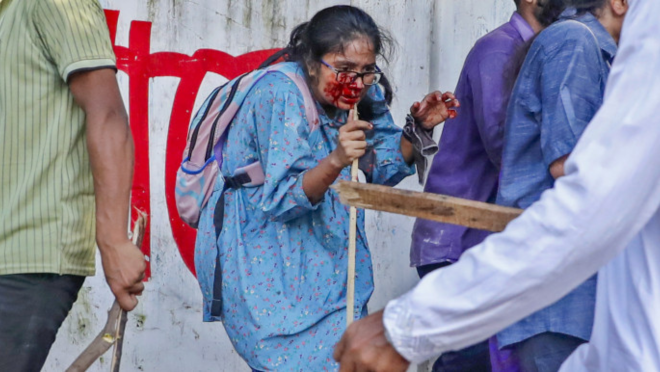15 July revisited: The day Dhaka University bled but didn't bow
15 July revisited: The day Dhaka University bled but didn't bow

Exactly a year ago, on 15 July, Dhaka University witnessed one of the darkest chapters in its history. The Bangladesh Chhatra League (BCL) — student wing of the now-fallen Awami League regime — unleashed unthinkable violence on unarmed students protesting against the quota system. Over a hundred were injured. For five harrowing hours, the campus turned into a war zone.
But the groundwork was laid the night before.
The quota reform movement was slowly gaining momentum, and then came the Prime Minister’s explosive comment in a press briefing on 14 July. When asked whether the movement opposed the spirit of the Liberation War, she snapped back: “If the grandchildren of freedom fighters do not receive benefits, should the grandchildren of Razakars receive them instead?”
The word Razakar — a slur historically used to label those who collaborated with the Pakistani army in 1971 — hit like a hard slap, a brutal stab in the back. But it wasn’t just the term. It was how she said it. Not razakar er shontan, but razakar er baccha — a term filled with utter disdain. And that’s how she dismissed an entire generation!
How could a prime minister label students as razakar?
The outrage was immediate and that very night, DU ignited like a volcano. By 10pm, students from multiple halls poured into the streets, converging at TSC. Female students broke open hall gates to join them. And in the silence of the night, voices roared:
Tumi ke? Ami ke? Razakar, razakar! (Who are you, who am I? Razakar, razakar!)
On the afternoon of 15 July, students gathered at the Raju Sculpture, demanding an apology from the PM and the end of the unjust quota system.
Around 2:15pm, protesters marched towards Hall Para. As they neared Bijoy Ekattor Hall, BCL leaders blocked their way and an immediate clash followed. These men, most of them outsiders, were in helmets—as if too coward to show their faces—with sticks, hockey sticks, stamps, iron rods and other sharp weapons in hand, and they attacked the protesters.
BCL activists from Ziaur Rahman and Mohsin Hall soon joined in. The students were beaten up with rods, pipes, sharp weapons. More than 250 students were injured, according to DMCH sources. Gunshots were fired near Shahidullah Hall. But there was a fierce resistance from up on the rooftop of Shahidullah Hall as students hurled brickbats at BCL members.
The BCL activists mercilessly beat the girls that day. Many were injured and taken to the hospital by rickshaw.
Photos began circulating online — one of them showed a girl, her face bloodied, bent forward in pain, dazed. That image became a symbol of how helpless the general students were before the government-backed BCL who terrorised them in their own campus.

The young boys and girls were screaming and running in every direction to save their lives. Blood spilled on the streets, shoes scattered everywhere. The scene at Dhaka Medical College Hospital was horrific. Injured students were arriving one after another, most of them bleeding profusely, their shirts soaked in blood, and some groaning. Lots of them had to settle on the floor. There was simply no room for the wounded in the hospital! When I watched these scenes online, I thought it was Gaza!
Those BCL men even attacked the injured inside DMC emergency room and Dhaka University medical centre.
What kind of coward attacks the wounded? What kind of man hides his face beneath a helmet and swings a pipe at a young girl?
Dhaka University bled that day. But it did not bow nor did it surrender.
What followed changed the nation’s history. The fire spread beyond DU — to every campus, every corner of the country. The youth stood up. And the regime, once arrogant in its power, began to crack. Eventually, it fell. Hasina fled. The government collapsed.
I wasn’t on campus that day. I was at my office, when the news started pouring in — raw footage, live updates, cries for help. I sat frozen, helpless, watching it all unfold on TV.
Even now, it feels like a wound that hasn’t healed. That day marked both an end and a beginning. The end of fear, and the birth of a new kind of courage. The students dreamed of Bangladesh 2.0. They dreamed of justice.
It’s been a year.
Students are back at campus, busy with regular classes, exams or usual hangouts at TSC. The university has expelled 128 students for their role in the attack. But have we truly arrived at the future the protesters fought for?
Not yet. Perhaps not even close.
Disappointment lingers, heavy as monsoon clouds. But as Andy once told Red in The Shawshank Redemption — “Hope is a good thing, maybe the best of things. And no good thing ever dies.”
No good thing ever dies. So be it.


